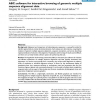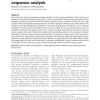7 search results - page 1 / 2 » Sigma-2: Multiple sequence alignment of non-coding DNA via a... |
BMCBI
2010
13 years 4 months ago
2010
Background: While most multiple sequence alignment programs expect that all or most of their input is known to be homologous, and penalise insertions and deletions, this is not a ...
GECCO
2003
Springer
13 years 9 months ago
2003
Springer
This article presents a model for DNA sequence alignment. In our model, a finite state automaton writes two-dimensional maps of nucleotide sequences. An evolutionary method for se...
GCB
2000
Springer
13 years 8 months ago
2000
Springer
Conventional phylogenetic tree estimation methods assume that all sites in a DNA multiple alignment have the same evolutionary history. This assumption is violated in data sets fro...
BMCBI
2004
13 years 4 months ago
2004
Background: Alignment and comparison of related genome sequences is a powerful method to identify regions likely to contain functional elements. Such analyses are data intensive, ...
BIB
2006
13 years 4 months ago
2006
One of the major goals of computational sequence analysis is to find sequence similarities, which could serve as evidence of structural and functional conservation, as well as of ...


